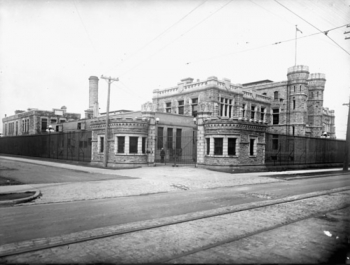2 January 1908
The right to mint coins has long been a jealously-held prerogative of the sovereign. During ancient and medieval times, those that tried to usurp this privilege risked dire punishments if caught, including death by decapitation, or by hanging, drawing and quartering. The severity of the punishment reflected the perceived severity of the crime—treason. A nation’s coinage was an extension of the sovereign whose image those coins carried. The making of money was also a very profitable business that the Crown wanted to protect for itself. The face value of the gold, silver or copper coins was higher than the intrinsic or bullion value of the metal. The difference was profit called “seigniorage,” meaning “belonging to the seigneur (lord).” The counterfeiting of coins carried the death penalty in Canada well into the nineteenth century.
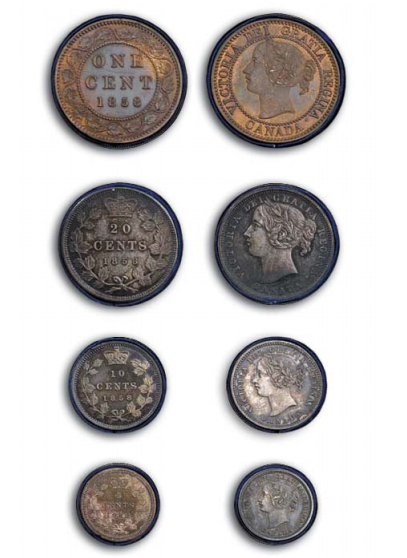 First series of distinctive Canadian coins, minted in England in 1858. Note the 20 cent piece. Bank of Canada Museum.In 1850, a shortage of coins led the government of the Province of Canada to pass legislation to establish a mint in Canada. Hitherto, all coins in circulation in Canada were minted in other countries, mostly Britain, the United States, Mexico and France. Although the legislation was signed into law by the Governor General, Lord Elgin, the act was “disallowed” by the Imperial government in London on the grounds that it involved “an uncalled for and most objectionable interference with the Prerogative of the ‘Crown.’” It didn’t help that the issue was part of a much broader tussle between the Canadian and British governments on whether Canada’s currency should be consistent with that of the United States, i.e. dollars and cents, or should conform to that used throughout the British Empire, i.e. pounds, shillings and pence.
First series of distinctive Canadian coins, minted in England in 1858. Note the 20 cent piece. Bank of Canada Museum.In 1850, a shortage of coins led the government of the Province of Canada to pass legislation to establish a mint in Canada. Hitherto, all coins in circulation in Canada were minted in other countries, mostly Britain, the United States, Mexico and France. Although the legislation was signed into law by the Governor General, Lord Elgin, the act was “disallowed” by the Imperial government in London on the grounds that it involved “an uncalled for and most objectionable interference with the Prerogative of the ‘Crown.’” It didn’t help that the issue was part of a much broader tussle between the Canadian and British governments on whether Canada’s currency should be consistent with that of the United States, i.e. dollars and cents, or should conform to that used throughout the British Empire, i.e. pounds, shillings and pence.
In the event, the forces in favour of using dollars and cents won the day. In 1858, the first distinctive Canadian coins, denominated in cents, were produced. However, the coins were made in England by the Royal Mint, the principal supplier of Canadian coinage for the next fifty years. Canadian coins were also minted by Ralph Heaton & Sons, a private Birmingham mint, when the Royal Mint was too busy to fill a Canadian coinage order. Such coins are identical to those made at the Royal Mint except for a small letter “H.”
In 1862, a mint was briefly established in New Westminster, British Columbia to convert gold that was being panned or mined along the banks of the Fraser River into useable coins. Hitherto, the gold bullion had to be transported at considerable cost to San Francisco for conversion with the profit going to the San Francisco mint. As James Douglas, the Governor of the colony, was initially supportive of the initiative, minting equipment was purchased from the United States. However, Douglas subsequently changed his mind. Nevertheless, he permitted a very small number of trial gold and silver pieces called patterns to be struck for the London Industrial Exhibition of 1862. Although most of the patterns were melted down after the exhibition, a few, which had been given to senior government officials, survived. These trial coins are among the rarest of Canadian coins. Examples were recently acquired by the Bank of Canada Museum.
Following the establishment of the Dominion of Canada in 1867, Canadian coins continued to be made in England. In the 1890s, Senator Thomas McInnes of British Columbia was the most prominent champion for the establishment of a mint in Canada. He argued that under the British North America Act the Dominion had the authority to establish a mint, and that a Canadian mint could profitably convert Canadian-mined gold, which mostly came from British Columbia, into coins. He added that mints had been established in Australia at both Melbourne and Sydney some thirty years earlier.
The federal government was not enthusiastic. It its judgement, there was not a lot of profit to be had in making gold coins. As well, the government feared that Canadian gold coins would displace Dominion notes that were already in circulation. (U.S. gold eagles and British gold sovereigns, while both legal tender in Canada, were seldom used.) Some also feared that a domestic mint would lead to pressures to make excessive amounts of subsidiary silver coins leading to inflation. Opponents also noted that the Australian examples cited by McInnes were not relevant as Australia used the same currency as Britain. Hence, the sovereigns, which were produced by the Australian mints to the same specifications as British-made sovereigns, could circulate freely in Britain. There were also concerns about the cost of establishing a Canadian mint. Some claimed that the annual demand for Canadian coins could be minted in just one month, leaving a domestic mint idle eleven months out of twelve.
Despite these objections, Senator McInnes introduced resolutions in the Senate in favour of a mint on at least two occasions. Each time, he was asked to withdraw it, something that he reluctantly did. Sitting as an independent, he did not have the backing of any political party. He was also known for championing the quixotic idea of making Gaelic an official language in Canada. Senator McInnes was appointed Lieutenant-Governor of British Columbia in 1897. Out of his depth in his new capacity, he was later fired by Governor General, Lord Minto, at the request of Sir Wilfrid Laurier.
The Canadian banking community was divided over the issue of a Canadian mint. Some saw merit in having one from a nationalistic standpoint. National mints were established in all important countries, including many smaller than Canada. However, others worried that Canadian-minted gold coins would find little acceptance outside of Canada. In transactions with the United States, they feared that U.S. banks would demand U.S. gold coins or bullion. Hence, Canadian gold coins would have to be melted down before the gold could be transferred to U.S. banks. Consequently, Canadian banks would likely continue to hold their reserves in readily usable U.S. gold coins.
But McInnes’ idea for a Canadian mint found supporters. Several Boards of Trade, including that of Ottawa, came out in favour of his plan on both economic and nationalistic grounds. In 1894, John Mara, a Conservative MP also from British Columbia, advocated the establishment of a Canadian mint to make silver coins using metal mined from his province. However, Sir George Eulas Foster, the Conservative Minister of Finance at the time, quashed the idea.
Government attitudes towards the establishment of a mint in Canada began to shift in 1899. In May of that year, the now Liberal Finance Minister William Fielding indicated that steps might be taken to establish a branch of the Royal Mint in Canada. In October 1900, he announced in Montreal that the government had entered negotiations with the British government and that enabling legislation to permit the establishment of a branch of the Royal Mint in Canada would be introduced in the next session of Parliament. He stated that since the new branch would be making British coins when not needed to mint Canadian coins, concerns that a Canadian mint would be underutilized had been addressed.
The Ottawa Mint Act was well received by both sides of the House of Commons, and was given Royal Assent in May 1901. The legislation appropriated up to $75,000 per year to cover salaries, contingencies, other allowances and expenses incurred in operating the branch of the Royal Mint. In return, all fees, duties or charges received or collected by the branch would be paid to the Canadian government. Mr Fielding, the Finance Minister, told the House that the Mint would be under the direction of experts from the Royal Mint in London, and that plans for a building had been submitted to Public Works with the cost of construction estimated at about $259,000. The minting machinery would cost an additional $64,000. While most of the minting equipment were to come from England, the electrical equipment for the facility was to be provided by Ottawa’s own Thomas Ahearn and Warren Soper. Annual maintenance expenses were placed at $65,000 annually. This would be more than covered by the seigniorage profits on the production of silver and copper coins; little profit was expected on the making of gold coins. Profit after expenses were estimated at no less than $20,000 per year. When not producing Canadian coinage, the branch would be making British sovereigns using Canadian gold.
The Minister also assured the House that there would not be a “reckless” coinage of silver coins. The silver issue would only be as large as the Canadian economy could absorb. He stated that no one wanted a “silver question” in this country. This was an allusion to the currency “battles” underway in the United States at that time between those who wanted easy money achieved through the free minting of silver coins, and those who favoured a strict adherence to the gold standard.
Despite widespread support for the establishment of a branch of the Royal Mint in Canada, it took several years to find an appropriate location for the new mint. One suggestion was to locate it at Nepean Point. This idea was rejected by the militia authorities who owned the land. The government took so long to find a building site that Mr Thomas Birkett, the MP for Ottawa, asked “if it was their [the government’s] intention to erect a mint or just dangle it in front of the electors of Ottawa.”
A site on Sussex Street was finally acquired in 1905 after lengthy negotiations with the Canadian Pacific Railway, the owner of the property. The CPR had initially asked $40,000 but settled for $21,500 after the government moved to expropriate the land that had an assessed value of $19,000. The government also acquired a neighbouring lot for $5,000. The actual building, which was constructed by Sullivan and Langdon of Kingston, Ontario, took two years to erect at an all-in cost (land, building and machinery) of $509,000, far higher than the original estimate. However, the government owned a state-of-the-art facility that was unmatched in the world. While senior officials and experts were brought over from the Royal Mint in London to manage and operate the new branch, most of the 60 plus Mint workers were Canadian, largely from the Ottawa area.
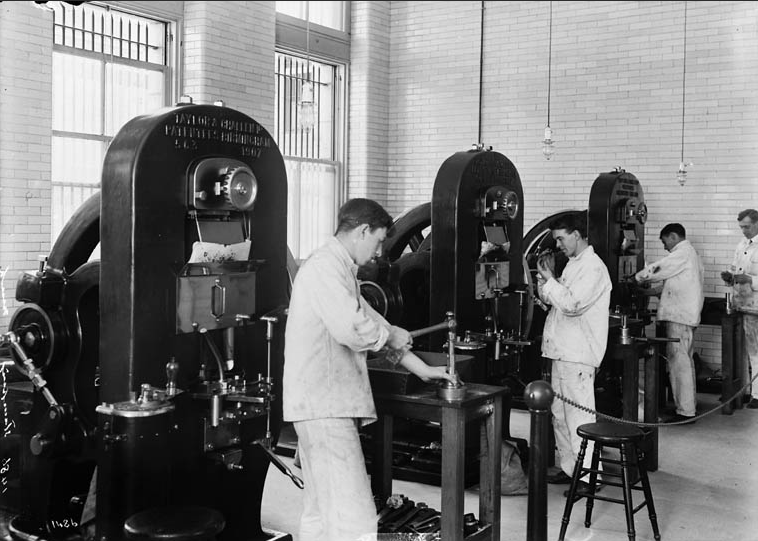 Steaming Operations, Royal Mint, Ottawa, 1909, Topley Studios/Library & Archives, PA-009646. At 3pm on 2 January 1908, the Governor General, Lord Grey, formally declared the Canadian branch of the Royal Mint open in front of roughly 300 guests, including Cabinet Ministers, Deputy Ministers, MPs, Senators, Supreme Court Justices, managers of all local banks, and other dignitaries, including Sir Sanford Fleming, the man who first proposed worldwide standard time zones. The guests were received by Dr J. Bonar, the head of the Ottawa Mint and his wife Mrs Bonar. Dr Bonar’s official title was Deputy Master since the British Chancellor of the Exchequer was the Master of the Royal Mint. Dr Bonar sent a cablegram to his counterpart at the Royal Mint in London announcing the formal start of Canadian operations. After the typical congratulatory speeches, guests were taken on a tour of the facility by Dr Bonar and Mr A. W. Cleeve, the Superintendent of the Mint.
Steaming Operations, Royal Mint, Ottawa, 1909, Topley Studios/Library & Archives, PA-009646. At 3pm on 2 January 1908, the Governor General, Lord Grey, formally declared the Canadian branch of the Royal Mint open in front of roughly 300 guests, including Cabinet Ministers, Deputy Ministers, MPs, Senators, Supreme Court Justices, managers of all local banks, and other dignitaries, including Sir Sanford Fleming, the man who first proposed worldwide standard time zones. The guests were received by Dr J. Bonar, the head of the Ottawa Mint and his wife Mrs Bonar. Dr Bonar’s official title was Deputy Master since the British Chancellor of the Exchequer was the Master of the Royal Mint. Dr Bonar sent a cablegram to his counterpart at the Royal Mint in London announcing the formal start of Canadian operations. After the typical congratulatory speeches, guests were taken on a tour of the facility by Dr Bonar and Mr A. W. Cleeve, the Superintendent of the Mint.
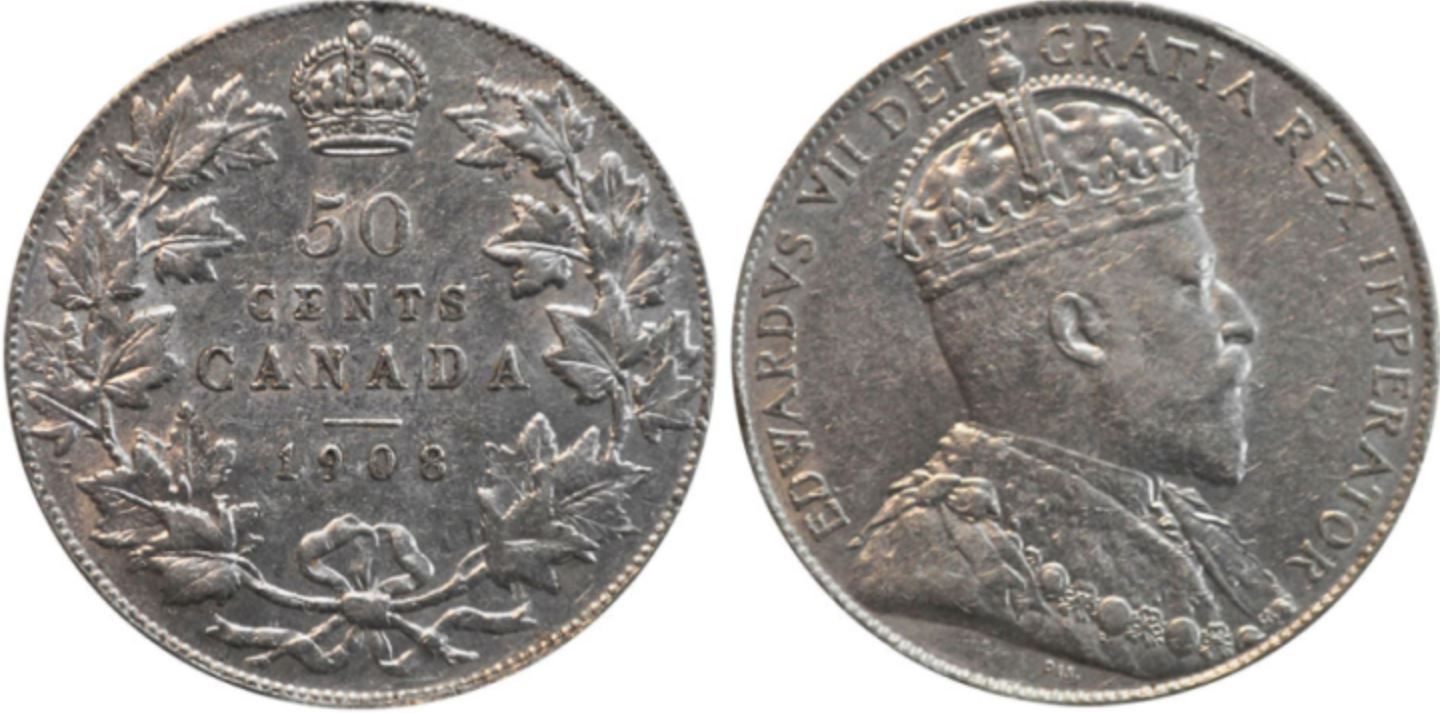 1908 Canadian silver 50 cent piece, the same as the first coin ceremonially struck by Lord Grey, Bank of Canada.The highlight of the afternoon was the striking of the first silver coin—a 50 cent piece—by the Governor General. This coin was placed in a small box with a blue satin interior and presented to Lady Grey. After this ceremony, the party moved to a copper stamping machine. There, Lady Grey raised the lever and struck the first copper coin to be minted in Canada. Each guest was presented with a newly-struck copper penny to commemorate the event.
1908 Canadian silver 50 cent piece, the same as the first coin ceremonially struck by Lord Grey, Bank of Canada.The highlight of the afternoon was the striking of the first silver coin—a 50 cent piece—by the Governor General. This coin was placed in a small box with a blue satin interior and presented to Lady Grey. After this ceremony, the party moved to a copper stamping machine. There, Lady Grey raised the lever and struck the first copper coin to be minted in Canada. Each guest was presented with a newly-struck copper penny to commemorate the event.
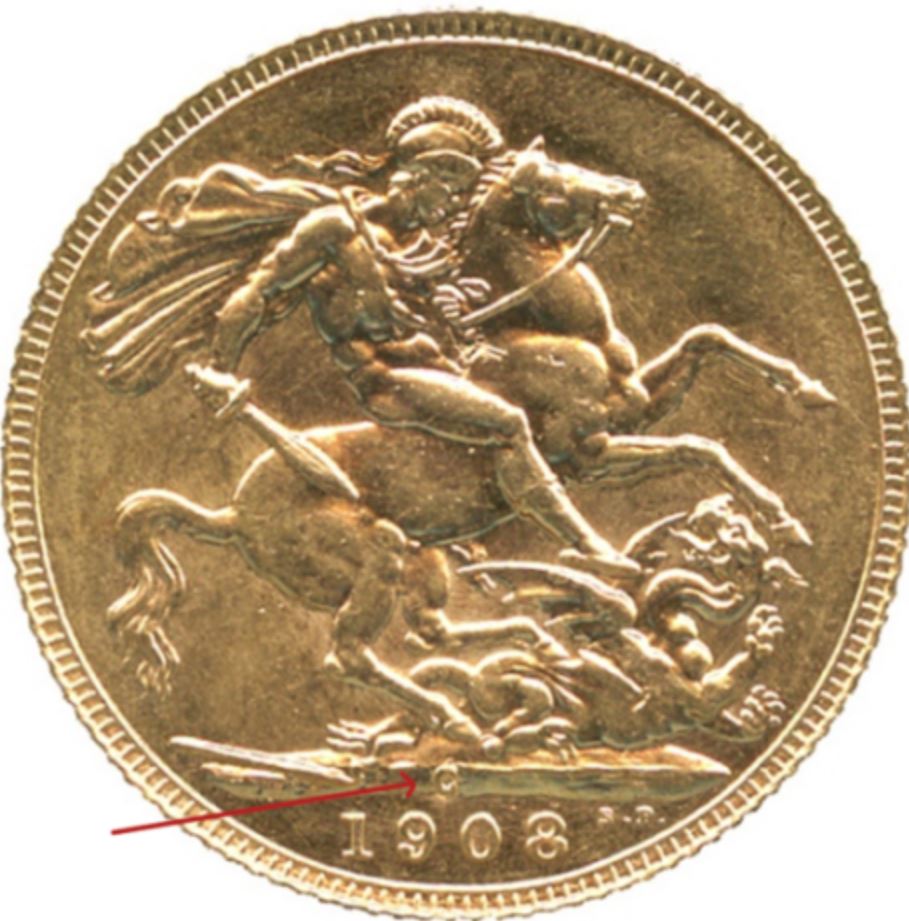 Canadian-minted British sovereign, 1908. The small “C” (indicated by red arrrow) above the date indicates its Canadian provenance, Bank of Canada.At the start, the new Royal Mint branch focused on making subsidiary, i.e. silver and copper, Canadian coins. Its production of British sovereigns was limited to only 636 during 1908, the Mint’s first year of operation, though production did ramp up to almost 257,000 in 1911. (Given the limited production of the 1908 sovereign, the numismatic value of this coin today is considerable.) The gold sovereigns minted in Ottawa are identified with the letter “C” for Canada just above the date, but are otherwise identical to sovereigns minted in Britain. The Mint didn’t get around to coining Canadian $5 and $10 coins until 1912. Production was discontinued in 1914 at the beginning of World War I. The minting of gold sovereigns was also halted for a time. Production resumed from 1916 to 1919.
Canadian-minted British sovereign, 1908. The small “C” (indicated by red arrrow) above the date indicates its Canadian provenance, Bank of Canada.At the start, the new Royal Mint branch focused on making subsidiary, i.e. silver and copper, Canadian coins. Its production of British sovereigns was limited to only 636 during 1908, the Mint’s first year of operation, though production did ramp up to almost 257,000 in 1911. (Given the limited production of the 1908 sovereign, the numismatic value of this coin today is considerable.) The gold sovereigns minted in Ottawa are identified with the letter “C” for Canada just above the date, but are otherwise identical to sovereigns minted in Britain. The Mint didn’t get around to coining Canadian $5 and $10 coins until 1912. Production was discontinued in 1914 at the beginning of World War I. The minting of gold sovereigns was also halted for a time. Production resumed from 1916 to 1919.
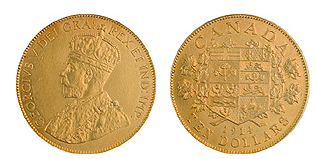 Canadian $10 gold piece, minted in Ottawa, 1914, Bank of Canada.
Canadian $10 gold piece, minted in Ottawa, 1914, Bank of Canada.
In August 1931, the Conservative Government of R.B. Bennett severed the link between the Royal Mint and its Canadian branch. Under new legislation, the Ottawa facility commenced operations as the Royal Canadian Mint reporting to the Minister of Finance. In 1969, the Mint became a Crown Corporation. Today, the Royal Canadian Mint’s Sussex Avenue facility produces Canadian collector and commemorative coins. Circulating Canadian coins are produced at the Mint’s Winnipeg’s facility that was opened in 1976. This facility also produces coins for many other countries.
Sources:
Berry, Paul, 2017. “New Acquisitions: British Columbia Gold Pieces,” Bank of Canada Museum, 30 May.
Canada, Government of, 1931. An Act respecting the establishment of the Royal Canadian Mint.
Canada, Province of, 1851. Appendix to Journals of the Legislative Assembly, “Message, Dispatch from Her Majesty’s Secretary of State for the Colonies communicating Her Majesty’s disallowance of an Act of last Session, entitled, “An Act to Amend the Currency Act of this Province,” also, of sundry communications in relation to that Act,” 28 July.
Canadian Coin News, 2015. Rare 1862 gilt coins offer glimpse into B.C.’s gold rush, 18 August, http://canadiancoinnews.com/rare-1862-gilt-coins-offer-glimpse-into-b-c-s-gold-rush/.
Chard, 2017. Gold Sovereigns, Branch Mints – Ottawa Canada, https://goldsovereigns.co.uk/ottawamintcanada.html.
Evening Citizen (The), 1907. “Mint Will Open Thursday,” 31 December.
Evening Journal (The), 1890, “The Question Of A Mint For Canada,” 5 May.
————————–, 1894. “Canada’s Native Silver,” 19 July.
————————–, 1897. “Wanted A National Mint,” 18 May.
————————–, 1897. “National Mint Wanted,” 3 June.
————————–, 1899. “Resolution Favoring A Canadian Mint,” 16 May.
————————–, 1900. “A Dominion Gold Coinage,” 24 October.
————————–, 1907. “Money Making Experts Here,” 12 September.
————————–, 1908. “Formal Opening of Royal Mint,” 3 January.
————————–, 1909. “A Gold Coinage,” 20 October.
————————–, 1912. “The Annual Address of the Imperial Bank’s President,” 28 May.
J&M Coin & Jewellery Ltd. 2017. Canadian Gold Sovereigns, 1908-1919, https://www.jandm.com/script/getitem.asp?CID=3&PID=50.
Powell, J. 2005. A History of the Canadian Dollar, Bank of Canada.
Powell, J. & Moxley, J. 2013. Faking It! A History of Counterfeiting in Canada, General Store Publishing House: Renfrew.
Royal Engineer (The), 2017. The Gosset Gold Coin Affair, http://www.royalengineers.ca/GossetGold.html
Story written by James Powell, the author of the blog Today in Ottawa's History.
Retired from the Bank of Canada, James is the author or co-author of three books dealing with some aspect of Canadian history. These comprise: A History of the Canadian Dollar, 2005, Bank of Canada, The Bank of Canada of James Elliott Coyne: Challenges, Confrontation and Change,” 2009, Queen’s University Press, and with Jill Moxley, Faking It! A History of Counterfeiting in Canada, 2013, General Store Publishing House, Renfrew, Ontario. James is a Director of The Historical Society of Ottawa.



